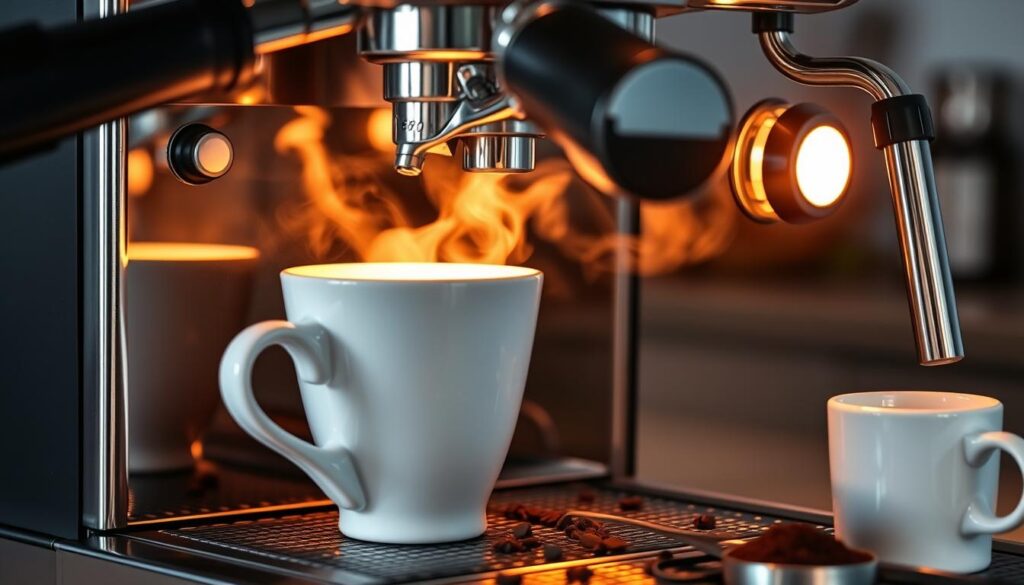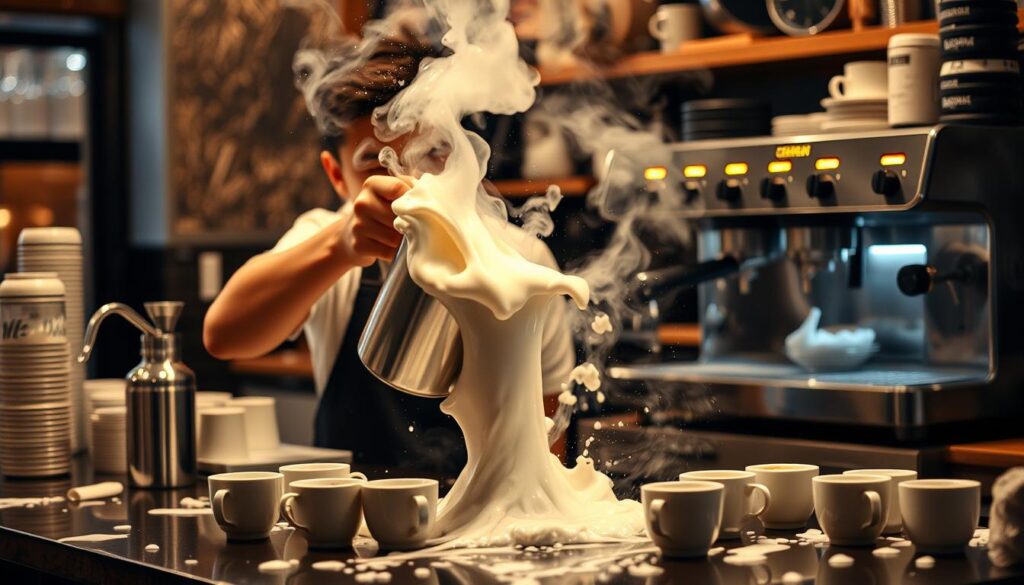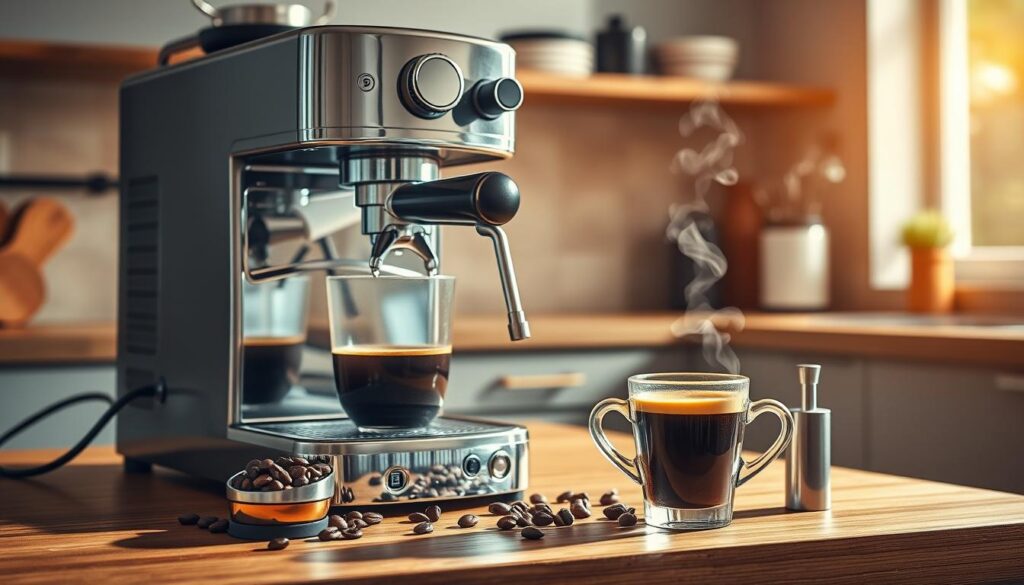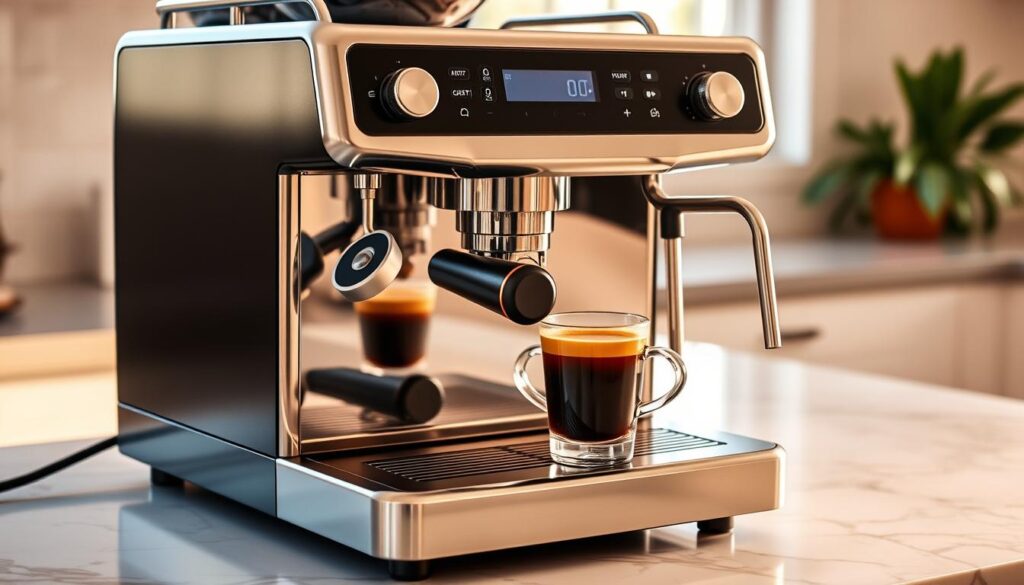This website contains affiliate links. As an Amazon Associate, I earn from qualifying purchases. The content on this website was created with the help of AI.
Starting to make espresso at home is both thrilling and challenging for beginners. This guide helps you avoid common mistakes. It covers everything from choosing the right machine to perfecting your brew.
Our tips will help you make drinks as good as those from a cafe. Learn how to fix common problems with your espresso machine. This will make your coffee-making journey even better.
Choosing the Wrong Espresso Machine
Choosing the right espresso machine is key to getting the coffee you want. It’s important for both home baristas and commercial places. Making the right choice can make your coffee-making better.
Understanding Your Needs
First, know what you need. Home users might want something easy to use. Commercial places need machines that are durable and fast. Knowing this helps avoid wasting money and makes sure the machine fits your needs.
Types of Espresso Machines
There are many types of espresso machines. Each is for different levels of skill and convenience. Here are a few:
- Manual: Gives you full control but needs skill.
- Semi-Automatic: Lets you adjust the brewing, great for experimenting.
- Automatic: Makes brewing easier by controlling water flow.
- Super-Automatic: Does everything for you, perfect for ease.
Features to Consider
When looking at espresso machines, consider these important features:
- Temperature Control: Keeps the temperature right for the best coffee.
- Pressure Pumps: Good pumps make sure the coffee has a nice crema.
- Frothing Abilities: If you like lattes or cappuccinos, a good steaming wand is important.
Avoiding mistakes like picking the wrong machine or missing key features can make your coffee better. For more tips on getting your grinder right, check out this guide. Using these tips can make your espresso-making journey smoother and more enjoyable.
Improper Coffee Bean Selection
Choosing the right coffee beans is key to making the perfect espresso. It’s a common mistake beginners make, but it’s easy to fix. Freshness and roast level are crucial for the flavor of your espresso.
Why Fresh Beans Matter
Fresh beans are vital for a great espresso. Old beans can make your espresso taste flat and bitter. To get the best taste, look for beans roasted within two weeks.
Choosing the Right Roast
The roast level of your coffee beans affects the taste of your espresso. Light, medium, and dark roasts each bring unique flavors. Here’s a quick guide to help you pick the right roast:
| Roast Level | Flavor Profile | Notes |
|---|---|---|
| Light Roast | Bright, fruity, and acidic | Best for highlighting the bean’s origin flavors. |
| Medium Roast | Balanced, sweet, and rounded | Smooth taste, excellent for an everyday espresso. |
| Dark Roast | Bold, strong, and smoky | Ideal for those who prefer rich and intense espresso. |
By following these tips, you can avoid common mistakes beginners make. Choose your beans carefully, and you’ll be well on your way to mastering your espresso.
Incorrect Grinding of Coffee Beans
Many people overlook the importance of grind size in making espresso. It greatly affects the taste and quality of your coffee. Beginners often make common espresso machine blunders by not paying attention to grind size.
Impact of Grind Size on Flavor
The size of your coffee beans’ grind is key to flavor extraction. A too-coarse grind can result in sour and weak espresso. On the other hand, a too-fine grind can make your espresso bitter and harsh.
Finding that perfect medium grind is crucial. It should be fine but not powdery. This is important for avoiding espresso machine errors.
Using a Burr Grinder
Using a burr grinder is essential for consistent grind size. This is vital for a well-balanced espresso. Unlike blade grinders, burr grinders give a uniform grind that can be adjusted.
This consistency helps in espresso machine troubleshooting. It ensures you extract the best flavors from your coffee beans.
| Grind Type | Flavor Profile | Recommended for Espresso |
|---|---|---|
| Coarse | Sour, weak, under-extracted | No |
| Medium-fine | Balanced, optimal extraction | Yes |
| Fine | Bitter, harsh, over-extracted | No |
By focusing on these details, you can greatly improve your espresso. This helps avoid common espresso machine blunders related to grinding.
Ignoring the Importance of Water Quality
Water quality is key for great-tasting espresso and keeping your machine in good shape. Many tips for espresso machines stress the importance of the water you use. Poor water quality is a common problem for beginners, but it’s easy to fix.
Chlorine, minerals, and other impurities can change the taste of your espresso. Hard water can also cause scale build-up in your machine. This not only affects the flavor but also means you’ll need to descale your machine often.
To solve these problems, use filtered or bottled water. This helps avoid issues caused by too many minerals. It also helps your machine last longer, saving you from frequent maintenance.
Improving your water quality can fix many espresso machine problems and make your coffee better. Add these tips to your daily routine for a perfect cup every time.
Poor Tamper Technique
Making a great espresso starts with proper tamping. This is a common mistake beginners make. But, mastering tamping can greatly improve your coffee’s quality. Knowing the right tamper technique is key for an even extraction, which is vital for a balanced espresso.
Understanding Tamping Pressure
Getting the tamping pressure right is crucial. Aim for about 30 pounds of pressure. Too much or too little can make your espresso taste sour or bitter. A beginner espresso machine guide can help you learn the right amount of pressure to start with and how to adjust it.
Using a Tamper Correctly
It’s not just about the pressure. Beginners often forget about the tamp’s angle and evenness. Use the tamper level and apply even pressure to avoid channeling. Channeling happens when water finds weak spots in the coffee puck, leading to uneven extraction. Paying close attention to these details is the first step in avoiding espresso machine errors. With practice, you can improve your skills and make better espresso.
Not Preheating the Machine
Many people forget to preheat their espresso machine. This step is key for a perfect shot. It helps keep the temperature stable.

Benefits of Preheating
Preheating your espresso machine has many benefits:
- Optimal Temperature for Extraction: A preheated machine ensures the water is at the right temperature. This is crucial for getting all the flavors from the coffee.
- Consistent Shots: Preheating keeps the temperature stable. This means your shots will taste the same every time, which is important for espresso machine troubleshooting.
- Better Taste: Using hot water makes the coffee taste richer and more balanced.
How to Preheat Your Espresso Machine
Here’s how to preheat your espresso machine:
- Run a Blank Shot: Turn on the machine and run a shot without coffee. This heats up the machine’s parts.
- Warm the Portafilter: Put the portafilter in and run another shot. This warms it up for brewing.
- Preheat Your Cups: Fill your espresso cups with hot water. This keeps the coffee warm as it’s poured.
Preheating might seem like an extra step, but it’s crucial. It’s an important espresso machine tip for better shots. Paying attention to these details helps solve beginner espresso machine problems and improve your skills.
Incorrect Dosing of Coffee
Getting the right amount of coffee is key to making great espresso. Too much or too little coffee can ruin the taste and quality of your espresso.
For newbies, it’s important to avoid mistakes with coffee dosing. This is one of the main beginner espresso machine problems. Knowing the right amount of coffee is essential to avoid mistakes and improve your brewing.
Here are some espresso machine tips to help you:
- Use a digital scale to measure your coffee accurately. Aim for 18 to 20 grams for a double shot.
- Make sure your portafilter is dry before adding coffee. This prevents the grounds from sticking and causing uneven extraction.
- Level and spread the coffee evenly in the portafilter. This helps in getting a balanced extraction.
- Keep practicing to get better at dosing and achieve consistent results.
Here’s how overdosing and underdosing affect your espresso shot.
| Factor | Overdosing | Underdosing |
|---|---|---|
| Flavor | Too strong, bitter | Weak, watery |
| Extraction Time | Prolonged | Shortened |
| Crema | Excess, dark | Thin, light |
| Overall Quality | Unbalanced | Lacking flavor depth |
Common Mistakes Beginners Make with Espresso Machines (and How to Avoid Them)
Starting with espresso can feel like a big challenge. It’s not just about picking the right machine and beans. Keeping your machine in good shape and adjusting it right is key. If you ignore these steps, you might run into problems that hurt your coffee’s taste and your machine’s life.
Overlooking Maintenance
Keeping your espresso machine clean and descaled is crucial. It stops clogs and keeps it working smoothly. Simple tasks like backflushing, cleaning the portafilter, and wiping the steam wand can really help. Doing these things regularly keeps your coffee tasting great and your machine running longer.
Ignoring Calibration
Calibrating your espresso machine and grinder is vital. Small changes in grind size, water temperature, and pressure can greatly affect how your coffee tastes. Many newbies forget how important these adjustments are, leading to uneven results. By calibrating often, you can make sure every espresso shot is perfect, following the beginner’s guide.
| Action | Benefits |
|---|---|
| Regular Cleaning | Prevents build-up, extends machine life |
| Descaling | Maintains boiler efficiency |
| Calibration | Ensures consistent espresso quality |
Not following these maintenance tips can lead to avoidable mistakes. A good maintenance routine and regular calibration make for a better coffee experience. They also follow the best practices for beginners.
Poor Milk Steaming Technique
One common mistake beginners make is poor milk steaming. Learning to texture milk for cappuccinos and lattes can make your espresso better. It’s all about the right steam wand placement and motion for perfect microfoam. Here are some tips to help you avoid frothy mistakes and get great steamed milk.

Texturing Milk Perfectly
Texturing milk is more than frothing; it’s about making smooth, creamy microfoam. Start by placing the steam wand just below the milk’s surface at a slight angle. This helps mix air evenly for a velvety texture. Heat the milk to 150-155°F for the best taste and texture. With practice, you’ll get better at it, and avoiding mistakes will become easy.
Steam Wand Placement
The steam wand’s position greatly affects your steamed milk’s quality. For the best results, place it near the pitcher’s edge with a slight tilt. This creates a whirlpool effect, mixing air smoothly into the milk. Don’t put the wand too deep or too shallow, as this causes uneven foam. With regular practice, you’ll master this and improve your home coffee.
Neglecting Regular Cleaning
Keeping your espresso machine clean is key for its life and the taste of your coffee. A regular cleaning schedule helps avoid many issues and keeps your machine running well.
Daily Cleaning Routine
A daily cleaning routine is a must. It includes:
- Backflushing with water to get rid of coffee residue.
- Cleaning the group head to remove coffee oils and grounds.
- Clearing the steam wand after each use to stop milk buildup.
These steps might seem easy, but skipping them can cause big problems later.
Deep Cleaning Schedule
Besides daily cleaning, a deep clean is needed too. This should happen weekly or monthly, based on how often you use it. The deep clean involves:
- Taking apart important parts like the group head and steam wand.
- Soaking parts in a cleaning solution to remove tough buildup.
- Running descaling solutions through the machine to clear mineral deposits.
Taking these steps helps prevent many issues and cuts down on troubleshooting.
Skipping the Importance of Timing
Timing is key when making the perfect espresso shot. It’s a common mistake beginners make. A good beginner espresso machine guide will tell you that a shot should take about 25-30 seconds to brew. This time is crucial for getting the right mix of flavors, body, and crema.
Getting the timing right can make a big difference in your espresso’s taste. If it’s too short, the shot might taste sour and weak. On the other hand, if it’s too long, it could be bitter and too strong.
One way to fix timing issues is to adjust your grinder. The grind size affects how fast the coffee flows. Finer grinds slow it down, while coarser ones speed it up. By adjusting the grind, you can make sure your shots are always the same.
Using a timer while brewing can also help. Many espresso machines have timers built in. But you can also use an external timer for better consistency. By following these steps, you can avoid common mistakes and enjoy better coffee.
Conclusion
We’ve explored common mistakes beginners make with espresso machines. Each step is crucial, from choosing the right machine to mastering milk steaming. This guide aims to help you avoid these mistakes and improve your coffee-making skills.
Getting the grind right, using fresh water, and perfecting tamping are key. Fresh coffee beans and regular machine care are also vital. These factors ensure a great-tasting espresso every time.
By following these tips, you can avoid common errors and improve your espresso skills. You now have the knowledge to make barista-quality espresso at home. Enjoy your coffee-making journey!
This website contains affiliate links. As an Amazon Associate, I earn from qualifying purchases. The content on this website was created with the help of AI.



